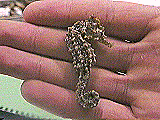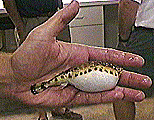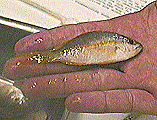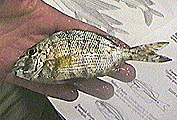 Yesterday we went seining and trawling. The mesh trawl net, which is dragged behind the boat, is pretty long and shaped like a cone. The mesh starts out large and gets continuously smaller. The mesh at the closed part of the net is very very small, small enough to hold the juvenile fish we we're after. The net is dragged for five minutes to standardize the numerous samples taken. After we pulled the net, we identified and measured the fish in the field. Later on, we reidentified a representative sample of the fish at the lab. We saw some really neat fish including lots of puffer fish, pipe fish, white grunts and even a seahorse!!
Yesterday we went seining and trawling. The mesh trawl net, which is dragged behind the boat, is pretty long and shaped like a cone. The mesh starts out large and gets continuously smaller. The mesh at the closed part of the net is very very small, small enough to hold the juvenile fish we we're after. The net is dragged for five minutes to standardize the numerous samples taken. After we pulled the net, we identified and measured the fish in the field. Later on, we reidentified a representative sample of the fish at the lab. We saw some really neat fish including lots of puffer fish, pipe fish, white grunts and even a seahorse!!
 Seining was really cool too. It was neat to be in the middle of the bay, no land in sight, hop out of the boat and be only knee deep in water! Seining involves dragging a net (a very heavy net as a matter of fact) through seagrass beds on shallow banks. We didn't catch as many fish seining as we did trawling, but it was just as much fun. While we were out on the bank, a shark swam between us and the boat! It was a small bonnet head shark and we were in no danger, but it was really cool.
Seining was really cool too. It was neat to be in the middle of the bay, no land in sight, hop out of the boat and be only knee deep in water! Seining involves dragging a net (a very heavy net as a matter of fact) through seagrass beds on shallow banks. We didn't catch as many fish seining as we did trawling, but it was just as much fun. While we were out on the bank, a shark swam between us and the boat! It was a small bonnet head shark and we were in no danger, but it was really cool.
The information that we gathered on the fish densities and the populations will help the Department of Environmental Protection advise the Marine Fisheries Commission how to decide regulations for fishing in the Bay.
 As we began to reidentify the fish, we were curious about to how the inside of the fish looked. We dissected some of them. Looking at fish in books is NOT the same as actually seeing and touching the live (or dead) thing. We looked for and found the brain, the lenses of the eyes, the swim bladder, the spleen ... we saw everything! Now, after identifying the fish, we have more of an appreciation for what to look for. We realize now that the teeth, the shape and NOT the color are so important for determining the actual scientific name.
As we began to reidentify the fish, we were curious about to how the inside of the fish looked. We dissected some of them. Looking at fish in books is NOT the same as actually seeing and touching the live (or dead) thing. We looked for and found the brain, the lenses of the eyes, the swim bladder, the spleen ... we saw everything! Now, after identifying the fish, we have more of an appreciation for what to look for. We realize now that the teeth, the shape and NOT the color are so important for determining the actual scientific name.
 The scientists we have been working with have been wonderful about helping us. Being here for only a week, we don't have the experiences and the knowledge that they do. The knowledge that they have is amazing! They have provided detailed explanations on the things that we are interested in. Without these people, JASON would not be the great project that it is.
The scientists we have been working with have been wonderful about helping us. Being here for only a week, we don't have the experiences and the knowledge that they do. The knowledge that they have is amazing! They have provided detailed explanations on the things that we are interested in. Without these people, JASON would not be the great project that it is.
Safia Rawoot & Kristy Holland
Florida Bay Team
![]() Back to January Expedition Journal
Back to January Expedition Journal
![]()
![]()
JASON Project homepage ||
Teachers' Guide ||
Students' Corner ||
Search
Gene Carl Feldman
(gene@seawifs.gsfc.nasa.gov)
(301) 286-9428
Todd Carlo Viola, JASON Foundation for Education (todd@jason.org)
Revised: 26 Jan 1996